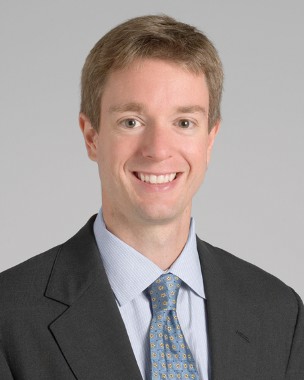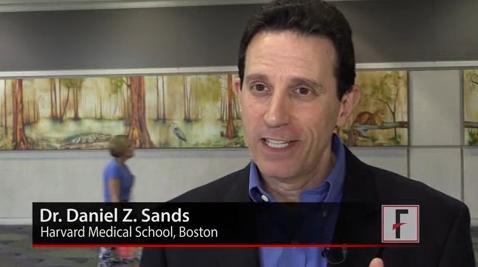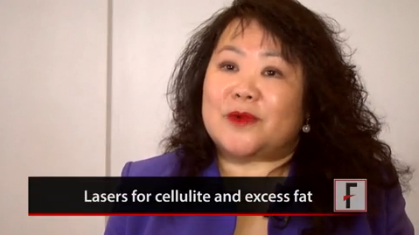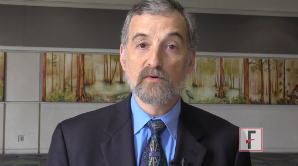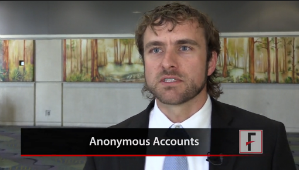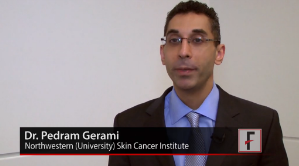User login
Despite barriers, telehealth growing rapidly
ORLANDO – Telehealth has been around for decades, but only recently, it has begun to gain momentum, as a result of advancements in technology. Yet, there are still barriers to overcome.
At the World Congress Leadership Summit on Hospital Readmissions, we spoke with the Cleveland Clinic’s Dr. William Morris and other leaders in the field to find out how they assessed current state of telehealth and its future potential.
On Twitter @naseemmiller
The video associated with this article is no longer available on this site. Please view all of our videos on the MDedge YouTube channel
ORLANDO – Telehealth has been around for decades, but only recently, it has begun to gain momentum, as a result of advancements in technology. Yet, there are still barriers to overcome.
At the World Congress Leadership Summit on Hospital Readmissions, we spoke with the Cleveland Clinic’s Dr. William Morris and other leaders in the field to find out how they assessed current state of telehealth and its future potential.
On Twitter @naseemmiller
The video associated with this article is no longer available on this site. Please view all of our videos on the MDedge YouTube channel
ORLANDO – Telehealth has been around for decades, but only recently, it has begun to gain momentum, as a result of advancements in technology. Yet, there are still barriers to overcome.
At the World Congress Leadership Summit on Hospital Readmissions, we spoke with the Cleveland Clinic’s Dr. William Morris and other leaders in the field to find out how they assessed current state of telehealth and its future potential.
On Twitter @naseemmiller
The video associated with this article is no longer available on this site. Please view all of our videos on the MDedge YouTube channel
AT THE HOSPITAL READMISSIONS SUMMIT
Florida ACO shares secrets to success
ORLANDO – Primary Partners, a Clermont, Fla.–based Accountable Care Organization, is among 27 ACOs in the federal government’s shared savings program. The ACO collaborates with five hospitals in four Florida counties and includes more than 60 physicians.
At the recent World Congress Leadership Summit on Hospital Readmissions, the ACO’s CEO, a participating physician, and the CEO of a collaborating hospital share what they've learned in the process, and what advice they'd give to hospitalists and physicians who are part of an ACO or considering joining one.
On Twitter @naseemmiller
ORLANDO – Primary Partners, a Clermont, Fla.–based Accountable Care Organization, is among 27 ACOs in the federal government’s shared savings program. The ACO collaborates with five hospitals in four Florida counties and includes more than 60 physicians.
At the recent World Congress Leadership Summit on Hospital Readmissions, the ACO’s CEO, a participating physician, and the CEO of a collaborating hospital share what they've learned in the process, and what advice they'd give to hospitalists and physicians who are part of an ACO or considering joining one.
On Twitter @naseemmiller
ORLANDO – Primary Partners, a Clermont, Fla.–based Accountable Care Organization, is among 27 ACOs in the federal government’s shared savings program. The ACO collaborates with five hospitals in four Florida counties and includes more than 60 physicians.
At the recent World Congress Leadership Summit on Hospital Readmissions, the ACO’s CEO, a participating physician, and the CEO of a collaborating hospital share what they've learned in the process, and what advice they'd give to hospitalists and physicians who are part of an ACO or considering joining one.
On Twitter @naseemmiller
AT THE HOSPITAL READMISSION SUMMIT
VIDEO: How to engage patients in their health
ORLANDO – Asking your patients about where they get their health information online is the first step toward helping them become "e-patients" – engaged patients who change their behaviors to improve their health, explains Dr. Daniel Sands.
And a willingness to answer a patient’s question with "I don’t know" can be the first step to becoming an engaged physician.
Dr. Sands has coauthored the book "Let Patients Help!" with Dave deBronkart, better known as "e-Patient Dave." He’s also the cofounder and cochair of the Society for Participatory Medicine, so he knows a thing or two about engaging patients in their health care and creating better outcomes.
In a video interview during the annual meeting of the American College of Physicians, Dr. Sands, who is with the department of medicine at Harvard Medical School in Boston, explains how physicians can use patients’ own online searches for health care answers to better involve patients in their health, and how physicians can work together with patients via technology to create a more satisfying experience in their practices.
The video associated with this article is no longer available on this site. Please view all of our videos on the MDedge YouTube channel
On Twitter @naseemmiller
ORLANDO – Asking your patients about where they get their health information online is the first step toward helping them become "e-patients" – engaged patients who change their behaviors to improve their health, explains Dr. Daniel Sands.
And a willingness to answer a patient’s question with "I don’t know" can be the first step to becoming an engaged physician.
Dr. Sands has coauthored the book "Let Patients Help!" with Dave deBronkart, better known as "e-Patient Dave." He’s also the cofounder and cochair of the Society for Participatory Medicine, so he knows a thing or two about engaging patients in their health care and creating better outcomes.
In a video interview during the annual meeting of the American College of Physicians, Dr. Sands, who is with the department of medicine at Harvard Medical School in Boston, explains how physicians can use patients’ own online searches for health care answers to better involve patients in their health, and how physicians can work together with patients via technology to create a more satisfying experience in their practices.
The video associated with this article is no longer available on this site. Please view all of our videos on the MDedge YouTube channel
On Twitter @naseemmiller
ORLANDO – Asking your patients about where they get their health information online is the first step toward helping them become "e-patients" – engaged patients who change their behaviors to improve their health, explains Dr. Daniel Sands.
And a willingness to answer a patient’s question with "I don’t know" can be the first step to becoming an engaged physician.
Dr. Sands has coauthored the book "Let Patients Help!" with Dave deBronkart, better known as "e-Patient Dave." He’s also the cofounder and cochair of the Society for Participatory Medicine, so he knows a thing or two about engaging patients in their health care and creating better outcomes.
In a video interview during the annual meeting of the American College of Physicians, Dr. Sands, who is with the department of medicine at Harvard Medical School in Boston, explains how physicians can use patients’ own online searches for health care answers to better involve patients in their health, and how physicians can work together with patients via technology to create a more satisfying experience in their practices.
The video associated with this article is no longer available on this site. Please view all of our videos on the MDedge YouTube channel
On Twitter @naseemmiller
AT ACP INTERNAL MEDICINE 2014
VIDEO: Concise guide to lasers: cellulite, tattoo removal, and skin tightening
DENVER – In 15 minutes, Dr. M. Christine Lee brings you a definitive guide to lasers for various patient needs, including tattoo removal, treatment of cellulite, skin tightening, and skin resurfacing. Learn more about lasers that you might want to add to your practice and get ideas on how to make the most of devices you already have.
Dr. Lee is with the department of dermatologic surgery at the University of California, San Francisco, and director of East Bay Laser & Skin Care Center in Walnut Creek, Calif. In this video, she also shares clinical pearls about different types of laser procedures.
The video associated with this article is no longer available on this site. Please view all of our videos on the MDedge YouTube channel
On Twitter @naseemmiller
DENVER – In 15 minutes, Dr. M. Christine Lee brings you a definitive guide to lasers for various patient needs, including tattoo removal, treatment of cellulite, skin tightening, and skin resurfacing. Learn more about lasers that you might want to add to your practice and get ideas on how to make the most of devices you already have.
Dr. Lee is with the department of dermatologic surgery at the University of California, San Francisco, and director of East Bay Laser & Skin Care Center in Walnut Creek, Calif. In this video, she also shares clinical pearls about different types of laser procedures.
The video associated with this article is no longer available on this site. Please view all of our videos on the MDedge YouTube channel
On Twitter @naseemmiller
DENVER – In 15 minutes, Dr. M. Christine Lee brings you a definitive guide to lasers for various patient needs, including tattoo removal, treatment of cellulite, skin tightening, and skin resurfacing. Learn more about lasers that you might want to add to your practice and get ideas on how to make the most of devices you already have.
Dr. Lee is with the department of dermatologic surgery at the University of California, San Francisco, and director of East Bay Laser & Skin Care Center in Walnut Creek, Calif. In this video, she also shares clinical pearls about different types of laser procedures.
The video associated with this article is no longer available on this site. Please view all of our videos on the MDedge YouTube channel
On Twitter @naseemmiller
EXPERT ANALYSIS FROM THE AAD ANNUAL MEETING
VIDEO: Practice pearls for treating opiate dependence
ORLANDO — What should you do when you have a patient who is opiate dependent, but is hospitalized for an unrelated medical reason? What should you do at discharge? And how effective are the available pharmacotherapies for addiction?
Dr. Jeffrey H. Samet, chief of general internal medicine at Boston University School of Medicine, Boston, shared a few clinical pearls in this video interview.
The video associated with this article is no longer available on this site. Please view all of our videos on the MDedge YouTube channel
On Twitter @naseemmiller
ORLANDO — What should you do when you have a patient who is opiate dependent, but is hospitalized for an unrelated medical reason? What should you do at discharge? And how effective are the available pharmacotherapies for addiction?
Dr. Jeffrey H. Samet, chief of general internal medicine at Boston University School of Medicine, Boston, shared a few clinical pearls in this video interview.
The video associated with this article is no longer available on this site. Please view all of our videos on the MDedge YouTube channel
On Twitter @naseemmiller
ORLANDO — What should you do when you have a patient who is opiate dependent, but is hospitalized for an unrelated medical reason? What should you do at discharge? And how effective are the available pharmacotherapies for addiction?
Dr. Jeffrey H. Samet, chief of general internal medicine at Boston University School of Medicine, Boston, shared a few clinical pearls in this video interview.
The video associated with this article is no longer available on this site. Please view all of our videos on the MDedge YouTube channel
On Twitter @naseemmiller
AT ACP INTERNAL MEDICINE 2014
VIDEO: The don'ts of social media for physicians
ORLANDO — If you’re on social media sites such as Twitter and Facebook, or considering joining one, there’s one type of post you should absolutely refrain from making.
In an interview at the American College of Physicians annual meeting, Dr. Matthew DeCamp, assistant professor at the Johns Hopkins Berman Institute of Bioethics and in the Johns Hopkins division of general internal medicine, revealed the type of post that poses greatest danger for clinicians, and outlined other tips for safely navigating social media as a physician.
On Twitter @naseemmiller
ORLANDO — If you’re on social media sites such as Twitter and Facebook, or considering joining one, there’s one type of post you should absolutely refrain from making.
In an interview at the American College of Physicians annual meeting, Dr. Matthew DeCamp, assistant professor at the Johns Hopkins Berman Institute of Bioethics and in the Johns Hopkins division of general internal medicine, revealed the type of post that poses greatest danger for clinicians, and outlined other tips for safely navigating social media as a physician.
On Twitter @naseemmiller
ORLANDO — If you’re on social media sites such as Twitter and Facebook, or considering joining one, there’s one type of post you should absolutely refrain from making.
In an interview at the American College of Physicians annual meeting, Dr. Matthew DeCamp, assistant professor at the Johns Hopkins Berman Institute of Bioethics and in the Johns Hopkins division of general internal medicine, revealed the type of post that poses greatest danger for clinicians, and outlined other tips for safely navigating social media as a physician.
On Twitter @naseemmiller
AT ACP INTERNAL MEDICINE 2014
VIDEO: Do you ask patients about guns in their homes?
ORLANDO – The American College of Physicians released a policy paper on April 10 calling gun violence a public health threat and asking physicians to discuss gun violence with their patients.
Physicians, however, vary in how they handle the issue, depending on where they work, or how they view the issue. In a series of onsite interviews with physicians attending the American College of Physicians annual meeting, we captured a snapshot of their own nuanced perspectives.
On Twitter @naseemmiller
ORLANDO – The American College of Physicians released a policy paper on April 10 calling gun violence a public health threat and asking physicians to discuss gun violence with their patients.
Physicians, however, vary in how they handle the issue, depending on where they work, or how they view the issue. In a series of onsite interviews with physicians attending the American College of Physicians annual meeting, we captured a snapshot of their own nuanced perspectives.
On Twitter @naseemmiller
ORLANDO – The American College of Physicians released a policy paper on April 10 calling gun violence a public health threat and asking physicians to discuss gun violence with their patients.
Physicians, however, vary in how they handle the issue, depending on where they work, or how they view the issue. In a series of onsite interviews with physicians attending the American College of Physicians annual meeting, we captured a snapshot of their own nuanced perspectives.
On Twitter @naseemmiller
AT ACP 2014
VIDEO: Battlefield lessons improve treatment of traumatic scars
DENVER – Military dermatologists have played an active role in helping wounded warriors with their scars, and those physicians’ practices, including the use of ablative fractional resurfacing, are now entering the civilian world to treat injuries from fire, car crashes, or blasts.
Earlier this year, a group of dermatologists published a consensus report to highlight best practices for laser treatment of traumatic scars. The groups, which included several military dermatologists, concluded that "laser treatment, particularly ablative fractional resurfacing, deserves a prominent role in future scar treatment paradigms, with the possible inclusion of early intervention for contracture avoidance and assistance with wound healing."
In a video interview at the American Academy of Dermatology’s annual meeting, Lt. Col. Chad M. Hivnor, USAF, MC, FS, USA, a staff dermatologist for the San Antonio (Tex.) Military Health System, discussed the use of lasers in treating traumatic scars, talked about the psychology of scars, and shared a few of his own practice pearls.
The video associated with this article is no longer available on this site. Please view all of our videos on the MDedge YouTube channel
On Twitter @naseemmiller
DENVER – Military dermatologists have played an active role in helping wounded warriors with their scars, and those physicians’ practices, including the use of ablative fractional resurfacing, are now entering the civilian world to treat injuries from fire, car crashes, or blasts.
Earlier this year, a group of dermatologists published a consensus report to highlight best practices for laser treatment of traumatic scars. The groups, which included several military dermatologists, concluded that "laser treatment, particularly ablative fractional resurfacing, deserves a prominent role in future scar treatment paradigms, with the possible inclusion of early intervention for contracture avoidance and assistance with wound healing."
In a video interview at the American Academy of Dermatology’s annual meeting, Lt. Col. Chad M. Hivnor, USAF, MC, FS, USA, a staff dermatologist for the San Antonio (Tex.) Military Health System, discussed the use of lasers in treating traumatic scars, talked about the psychology of scars, and shared a few of his own practice pearls.
The video associated with this article is no longer available on this site. Please view all of our videos on the MDedge YouTube channel
On Twitter @naseemmiller
DENVER – Military dermatologists have played an active role in helping wounded warriors with their scars, and those physicians’ practices, including the use of ablative fractional resurfacing, are now entering the civilian world to treat injuries from fire, car crashes, or blasts.
Earlier this year, a group of dermatologists published a consensus report to highlight best practices for laser treatment of traumatic scars. The groups, which included several military dermatologists, concluded that "laser treatment, particularly ablative fractional resurfacing, deserves a prominent role in future scar treatment paradigms, with the possible inclusion of early intervention for contracture avoidance and assistance with wound healing."
In a video interview at the American Academy of Dermatology’s annual meeting, Lt. Col. Chad M. Hivnor, USAF, MC, FS, USA, a staff dermatologist for the San Antonio (Tex.) Military Health System, discussed the use of lasers in treating traumatic scars, talked about the psychology of scars, and shared a few of his own practice pearls.
The video associated with this article is no longer available on this site. Please view all of our videos on the MDedge YouTube channel
On Twitter @naseemmiller
AT THE AAD ANNUAL MEETING
VIDEO: The DecisionDx-Melanoma test can predict metastasis of sentinel node-negative melanomas
DENVER – A 134-patient study of patients with stage I, II, or III cutaneous melanoma found that the DecisionDx-Melanoma test was useful for identifying a high-risk group of patients with negative sentinel lymph node biopsy results.
In a video interview, Dr. Pedram Gerami of the department of dermatology and director of melanoma research at the Northwestern University Skin Cancer Institute, Chicago, explains the best uses for the test and its patient management advantages.
The video associated with this article is no longer available on this site. Please view all of our videos on the MDedge YouTube channel
On Twitter @naseemmiller
DENVER – A 134-patient study of patients with stage I, II, or III cutaneous melanoma found that the DecisionDx-Melanoma test was useful for identifying a high-risk group of patients with negative sentinel lymph node biopsy results.
In a video interview, Dr. Pedram Gerami of the department of dermatology and director of melanoma research at the Northwestern University Skin Cancer Institute, Chicago, explains the best uses for the test and its patient management advantages.
The video associated with this article is no longer available on this site. Please view all of our videos on the MDedge YouTube channel
On Twitter @naseemmiller
DENVER – A 134-patient study of patients with stage I, II, or III cutaneous melanoma found that the DecisionDx-Melanoma test was useful for identifying a high-risk group of patients with negative sentinel lymph node biopsy results.
In a video interview, Dr. Pedram Gerami of the department of dermatology and director of melanoma research at the Northwestern University Skin Cancer Institute, Chicago, explains the best uses for the test and its patient management advantages.
The video associated with this article is no longer available on this site. Please view all of our videos on the MDedge YouTube channel
On Twitter @naseemmiller
AT THE AAD ANNUAL MEETING
VIDEO: AAD encourages members to be on top of ACA
DENVER – Dermatologists must get involved with their local medical societies and national groups, and they should learn more about the Affordable Care Act’s insurance exchanges and the accountable care organizations to be fully aware of how health reform is going to affect them.
That’s the advice from leaders at the American Academy of Dermatology annual meeting, who shared their perspectives on how dermatologists can best prepare themselves for the practice and market shifts that reform will bring. The academy itself has a comprehensive resource center on its website.
In a video interview, Dr. Marta J. VanBeek, chair of AAD Association’s Council on Government Affairs, Health Policy, and Practice, and director of dermatologic surgery at the University of Iowa, Iowa City, along with Dr. Kathryn Schwarzenberger, professor and Rex Amonette Endowed Chair of Excellence in Dermatology at the University of Tennessee, Memphis, spoke about why it’s important for dermatologists to be fully aware and educated about the Affordable Care Act.
The video associated with this article is no longer available on this site. Please view all of our videos on the MDedge YouTube channel
On Twitter @naseemmiller
DENVER – Dermatologists must get involved with their local medical societies and national groups, and they should learn more about the Affordable Care Act’s insurance exchanges and the accountable care organizations to be fully aware of how health reform is going to affect them.
That’s the advice from leaders at the American Academy of Dermatology annual meeting, who shared their perspectives on how dermatologists can best prepare themselves for the practice and market shifts that reform will bring. The academy itself has a comprehensive resource center on its website.
In a video interview, Dr. Marta J. VanBeek, chair of AAD Association’s Council on Government Affairs, Health Policy, and Practice, and director of dermatologic surgery at the University of Iowa, Iowa City, along with Dr. Kathryn Schwarzenberger, professor and Rex Amonette Endowed Chair of Excellence in Dermatology at the University of Tennessee, Memphis, spoke about why it’s important for dermatologists to be fully aware and educated about the Affordable Care Act.
The video associated with this article is no longer available on this site. Please view all of our videos on the MDedge YouTube channel
On Twitter @naseemmiller
DENVER – Dermatologists must get involved with their local medical societies and national groups, and they should learn more about the Affordable Care Act’s insurance exchanges and the accountable care organizations to be fully aware of how health reform is going to affect them.
That’s the advice from leaders at the American Academy of Dermatology annual meeting, who shared their perspectives on how dermatologists can best prepare themselves for the practice and market shifts that reform will bring. The academy itself has a comprehensive resource center on its website.
In a video interview, Dr. Marta J. VanBeek, chair of AAD Association’s Council on Government Affairs, Health Policy, and Practice, and director of dermatologic surgery at the University of Iowa, Iowa City, along with Dr. Kathryn Schwarzenberger, professor and Rex Amonette Endowed Chair of Excellence in Dermatology at the University of Tennessee, Memphis, spoke about why it’s important for dermatologists to be fully aware and educated about the Affordable Care Act.
The video associated with this article is no longer available on this site. Please view all of our videos on the MDedge YouTube channel
On Twitter @naseemmiller
At THE AAD ANNUAL MEETING
